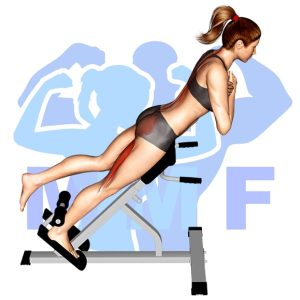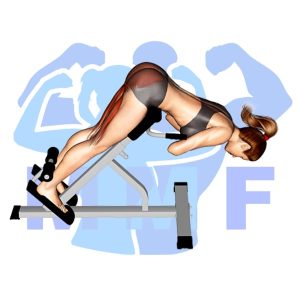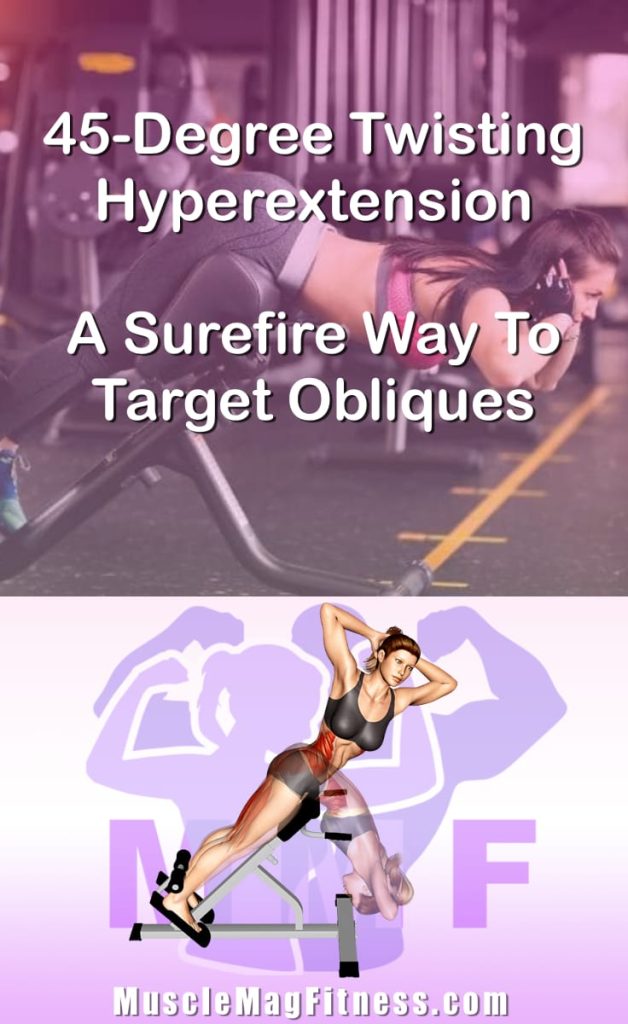Have you ever had a sharp pain in your lower back after lifting something heavy or doing an exercise like the 45 degree twisting hyperextension? Rest assured, you are not alone. Many people have experienced this discomfort due to poor form or overexertion. The good news is that this type of pain can be prevented with proper technique and strengthening exercises. In this blog post, we will discuss the common causes of lower back pain during the 45 degree twisting hyperextension, and provide solutions to help you perform this exercise safely and effectively.
45 Degree Twisting Hyperextension Summary
- Primary Muscles: Erector Spinae
- Secondary Muscles: Gluteus Maximus, and Hamstrings
- Equipment: Hyperextension Bench
- Mechanics Type: Compound
- Force: Pull
- Utility: Basic or Auxiliary

45 Degree Twisting Hyperextension Instructions
- Get started by setting up normally in the hyperextension machine. Placing your hands behind your head will help you twist at the top.
- Lower your upper body straight down without twisting.
- Once you are at the bottom, pull yourself back up, but on the way up, twist your upper body by pointing one elbow forward and one back.
- Lower your body down straight.
- Continue the 45 Degree Twisting Hyperextension for a complete set.
Video Tutorial
45 Degree Twisting Hyperextension Muscles
Target (Agonist)
Synergists
Dynamic Stabilizers
- None
Stabilizers
- Latissimus Dorsi
- Levator Scapulae
- Rhomboids
- Trapezius – Lower
- Trapezius – Middle
- Trapezius – Upper
Antagonist Stabilizers

Benefits of 45 Degree Twisting Hyperextension
The 45 Degree Twisting Hyperextension is an effective exercise for strengthening the Erector Spinae, a muscle group that supports the spine and helps stabilize the core. By performing this exercise, you can target this important muscle group, helping to reduce back pain and improve posture. Additionally, the twisting motion also targets the obliques, which helps to improve balance and coordination while helping to tone the abdominal muscles. Finally, this exercise can help to increase flexibility in the lower back and hips, allowing you to perform other exercises with greater ease and efficiency.
Tips for Performing 45 Degree Twisting Hyperextension
You’ve come to the right place if you’re motivated to advance your 45 degree twisting hyperextension performance. These tips can help you get the most out of this beautiful workout, and help you receive all the benefits it has to give. In addition to shaping your core and back muscles, increasing movability, and even a lower possibility of injury can all be accomplished with this exercise. It is time to begin and take a look at how these suggestions will benefit you.
- Keep your feet together and your hips aligned with the ground: Keeping your feet together and your hips aligned will help you maintain proper form throughout the exercise and ensure that you are engaging the correct muscles for maximum benefit.
- Keep your chest up and your back straight: Keeping your chest up and back straight during the 45 Degree Twisting Hyperextension will help protect your lower back from injury and help you get the most out of the exercise.
- Use slow and controlled movements: Moving slowly and deliberately through the exercise will help you better focus on the muscles being used, leading to improved results and better overall conditioning.
Benefits and Tips Video
Frequent Mistakes To Avoid
When executing 45 degree twisting hyperextension, avoiding typical errors can be the difference between a productive workout and a debilitating injury. Moreover, getting optimal results from this exercise requires proper technique, and making sure you don’t make any common errors can allow you to perform the exercise correctly and achieve your desired results. But relax, it’s not as challenging as it might appear. By knowing the errors to avoid and taking the right actions, you can execute the activity safely and successfully. Let’s begin by avoiding these typical mistakes and add this exercise to your training regimen.
- Not engaging the core muscles: Not engaging the core muscles while performing this exercise can make it less effective and increase the risk of injury.
- Not maintaining proper form: Poor form can lead to injury, reduce the effectiveness of the exercise, and can create muscle imbalances which may cause long-term damage.
- Holding the breath: Holding the breath during this exercise can increase the risk of injury and decrease the effectiveness of the exercise. It’s important to maintain a steady rhythm of breathing during the movement to keep your body safe and get the most out of the exercise.
Find More Bodyweight Exercises Here
Variations and Complementary Exercises
If you’re looking for variations, complementary, or alternative exercises to the exercise 45 Degree Twisting Hyperextension, here are a few that you can try:
45 Degree One Leg Hyperextension

The 45 Degree One Leg Hyperextension is an alternative or complementary exercise to the 45 Degree Twisting Hyperextension. It focuses on isolating one leg at a time to work the gluteus maximus, hamstrings, and lower back muscles. It is performed on a hyperextension bench, with one leg bent and tucked underneath the pad while the other leg hangs off the edge of the bench. The torso is then lowered until a 90 degree angle is formed between the upper and lower body, and then raised back up to its original position. This exercise helps to strengthen and tone the muscles of the lower back, glutes, and hamstrings, while also improving core strength and stability.
45 Degree Hyperextension

The 45 Degree Hyperextension is an excellent alternative or complementary exercise to the 45 Degree Twisting Hyperextension. The 45 Degree Hyperextension focuses on the lower back and helps to strengthen the muscles along the spine, while the 45 Degree Twisting Hyperextension primarily works the abdominal muscles. This exercise is performed by lying on a flat bench, with your feet secured at the end and your hands placed behind your head. You then slowly lift your upper body off the bench, so that your torso is parallel to the ground. The key to performing this exercise effectively is to keep your back straight and to control your motion throughout the entire range of motion. The 45 Degree Hyperextension is an effective way to increase strength and stability in the lower back, and can be used as either an alternative or a complementary exercise to the 45 Degree Twisting Hyperextension.
Straight Leg Cable Pull Through

The Straight Leg Cable Pull Through is a great complementary or alternative exercise to the 45 Degree Twisting Hyperextension. It works the same muscles, but with a different angle of resistance. The exercise involves standing on one leg with the other leg straight behind you. You then pull the cable through with both arms while keeping your torso and hips still. This exercise is great for strengthening the lower body while also increasing core stability and balance. It’s an effective way to target the glutes, hamstrings, and lower back muscles in a different way than with the 45 Degree Twisting Hyperextension.
Check Out These Top Bodyweight Exercises
Bird Dog Plank

Bird Dog Plank is a great alternative or complementary exercise to the 45 Degree Twisting Hyperextension. Bird Dog Plank works the same muscle groups as the 45 Degree Twisting Hyperextension, but it adds an extra challenge by requiring the core muscles to stay engaged for the duration of the exercise. The Bird Dog Plank requires you to lift one leg and the opposite arm off the ground while maintaining a straight back and holding your body in a plank position. This exercise will increase core strength, flexibility, and balance, while also working on your posture.
Smith Machine Hip Thrust

The Smith Machine Hip Thrust is a great complementary or alternative exercise to the 45 Degree Twisting Hyperextension. The Hip Thrust involves sitting on the floor with your back against the Smith Machine bar and then pushing the bar up with your hips. This exercise works the glutes, hamstrings, and core, which are all key muscles used in the 45 Degree Twisting Hyperextension. The Smith Machine Hip Thrust also allows you to add weight to the exercise which can increase the intensity and effectiveness of the movement. By adding this exercise to your routine, you can target your glutes and hamstrings while also increasing core strength.
Cable Glute Kickbacks

Cable Glute Kickbacks can be a great complementary or alternative exercise to the 45 Degree Twisting Hyperextension. This exercise focuses on the glutes and hamstrings, while also engaging the core muscles to help stabilize the body. The cable provides a constant tension that helps to target the desired muscles and allows for a greater range of motion than with traditional bodyweight exercises. Cable Glute Kickbacks are an excellent way to build strength and stability in the lower body, which can help improve performance in other exercises such as the 45 Degree Twisting Hyperextension.
Find More Lower-Back Exercises Here
Opposing Complementary Exercises
In order to maximize the effectiveness of the 45 Degree Twisting Hyperextension exercise, it is important to incorporate exercises that work the opposing muscle groups. Doing so will help to create balance in the body and can help to prevent injury. Below are a few exercises that can be done to supplement the 45 Degree Twisting Hyperextension:
Bridge

The Bridge exercise is a great complement to the 45 Degree Twisting Hyperextension exercise. It works the opposing muscle group by strengthening the glutes and hamstrings. This exercise helps to improve balance, stability and mobility in the lower back and hips. The Bridge helps to strengthen the core, which can help to protect the spine from injury and reduce pain. By strengthening the opposing muscle groups, the Bridge can improve the effectiveness of the 45 Degree Twisting Hyperextension. This can help to improve flexibility and range of motion in the lower body, making it easier to perform this exercise correctly and with good form.
Bench Crunch

Bench Crunch is a great complement to the 45 Degree Twisting Hyperextension exercise. This exercise targets the lower abdominal muscles, while the Bench Crunch focuses on the upper abdominal muscles. Both exercises work together to strengthen the core and improve overall stability and balance. The Bench Crunch helps to stabilize the spine and pelvis while performing the Twisting Hyperextension, which increases the effectiveness of the exercise. Additionally, Bench Crunch also helps to increase flexibility and range of motion in the torso, which can help improve posture. By engaging opposing muscle groups, Bench Crunch and 45 Degree Twisting Hyperextension are an effective combination for building a strong core.
V Up

The V-Up is a great complementary exercise to the 45 Degree Twisting Hyperextension because it targets the same muscle group but in an opposing manner. The V-Up works the core, lower back, and hip muscles by having the individual sit up and reach forward while lifting their legs off the ground. This exercise forces the core to work hard to stabilize the movement and is great for strengthening the muscles that are not targeted by the 45 Degree Twisting Hyperextension. Doing both exercises together gives the body a full workout and helps ensure that all muscles in the core area are being worked.
Get Abs of Steel with the 45 Degree Twisting Hyperextension!
Are you looking for a challenging workout to target your abs? Look no further than the 45 degree twisting hyperextension. This exercise not only works your abdominal muscles, but also your lower back and obliques. By twisting your torso during the movement, you engage your core muscles even more. Incorporate this exercise into your routine a few times per week and watch as your abs become stronger and more defined over time. Remember to start with a lower weight and gradually increase as you become more comfortable with the movement.
References: Wikipedia | ExRx.net | PubMed.gov | Comprehensive List of Lower-Back Bodyweight Exercises

